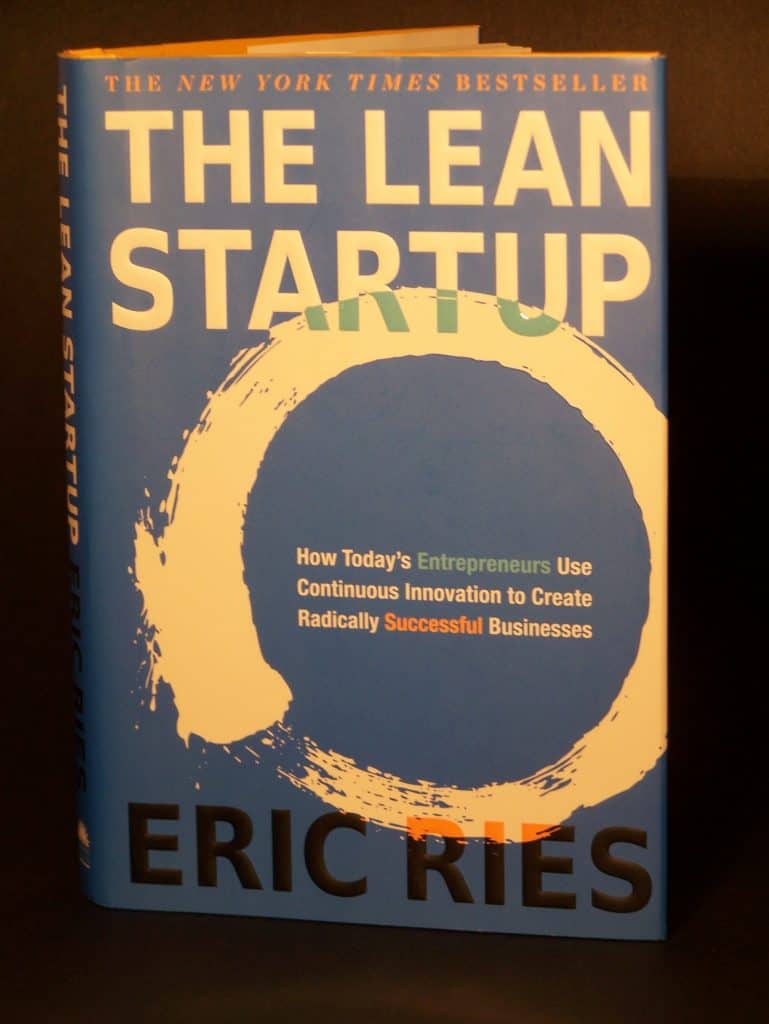
Book Summary – The Lean Startup

Many professionals in “corporate America” have been exposed to the concept of “lean”. In his book The Lean Start Up, Eric Ries takes these principles and describes a process that entrepreneurs can leverage to accelerate the development of and increase the probability of success of their businesses. What is particularly unique about this book is that it is applicable beyond entrepreneurs. In fact, the principles outlined in the text are 100% applicable to those who have decided to remain in “corporate America”. Ries argues that today’s corporate business environment is much faster, much less stable, and much less predictable. This higher degree of velocity and uncertainty necessitates a change in the way of thinking. In particular, it compels a move more towards something akin to rapid prototyping combined with extreme speed of deployment. By presenting the consumer/end user with the product/service early in the process feedback is obtained that allows the product/service to be modified to meet market expectations. This is in direct contrast to the “mega-projects” which permeate much of the traditional corporate culture.
Ries begins with five basic principles:
- Entrepreneurs are everywhere – Whether acting alone as individual business people or driving new initiatives within the traditional corporate structure, innovative business leaders are pervasive.
- Entrepreneurship is management – The entrepreneur is responsible for the coordination of a complex set of tasks. Viewed this way, successful corporate managers are successful entrepreneurs.
- Validated learning – Perhaps the most important principle in the book. We learn by trying new things and failing. Each failure – assuming the test was properly structured – provides the necessary feedback to move closer to achieving the entrepreneur’s ultimate vision.
- Build-measure-learn – A throw back to the age old tradition of hypothesis testing. Develop the hypothesis, construct the test apparatus, measure the results, and modify accordingly.
- Innovation accounting – The second key principle from Ries. Companies are used to measuring progress primarily in terms of dollars. Ries argues that while dollars are important, the “new” accounting involves measuring (i) introduction of a minimum viable product (MVP), (ii) evaluating the deviation of this product from the ideal state, and (iii) either pivoting or persevering. By focusing on these process metrics – versus the traditional output metrics – you drive an entirely different result.
Part One – Vision
In part one of the book, Ries focuses on “Vision”. Here he introduces his new schema and slowly indoctrinates the reader to his way of thinking. That’s entirely necessary as he’s flying in the face of many well established, long standing traditions. After going through these initial four chapters, the reader will be primed for the next stage. These initial chapters are:
- Start – He highlights the importance of moving forward/beginning and avoiding the “paralysis by analysis trap”
- Define – A critical chapter in the book. Ries highlights where the principles of the lean startup most apply: “A startup is a human institution designed to create a new product or service under conditions of extreme uncertainty”. It’s this uncertainty that necessitates a change in paradigm away from the “mega-project” to the rapid deployment/test approach Ries advocates.
- Learn – Here Ries makes the transition. He argues that learning, and in particular validated learning, it the key step for the entrepreneur. He argues that in the space of new products you will never know whether you are on the right path unless you get direct feedback from the customer. He highlights his experience with a product that totally transformed based on customer feedback. To be successful when moving into the unknown, you must deliver a prototype quickly to validate your hypothesis. This fear not / deploy the first product quickly approach is critical to success; AND, is in direct opposition to traditional corporate culture.
- Experiment – You can think of this as the test unit for learning. Validated learning can only take place by actually deploying the product and getting feedback. Each cycle should be thought of as an experiment.
Part Two – Steer
One of the main focuses of “lean” is to never stop learning and never stop growing. In part two, Ries introduces the concept of the build-measure-learn process. He walks through a methodology to use this process to “steer” your company through the product development cycle. The chapters in this section are:
- Leap – You need to recognize that nothing is guaranteed with a new venture. As result leaps of faith will be required. The key is to monitor these leaps of faith via the build-measure-learn cycle. Your leaps need to REVOLUTIONARY versus EVOLUTIONARY (think Apple). Further, it’s not enough that you think they are revolutionary. You need to quickly introduce the new product to the actual customer and get their feedback on what works and what does not work. Finally, Ries cautions on the biggest risk – paralysis by analysis.
- Test – The concept of test is at the heart of the lean start up. You need to quickly develop a “minimally viable product” (MVP). The MVP should NOT be perfect and will NOT have all of the features you desire. It WILL be deployed quickly to your targeted customer (think in terms of an avatar). Failures will be common in each test. In fact, failures are what you are looking for in the test – through your failures you will learn what does not work and gain insight in to what your ideal customer wants.
- Measure – Here Ries introduces the concept of innovation accounting. The key to understanding innovation accounting is to reject the traditional view of accounting that is built around dollars, debits, and credits. Instead you need to measure three things. First, you need to measure the performance of your MVP. The key here is that you’re going to get early feedback on your baseline. Second, you need to measure the deviation from your MVP to the ideal state that your clients tell you about – what is “perfection” and how far are you from it? Third, you need to make the decision to either persevere (i.e. iterate with a new product design) or pivot (i.e. recognize that the market is not as you expected and move in a new direction). By focusing on this process centric approach (market based) versus an output centric approach (financial based), you will develop products that are a better fit to your market AND are delivered more quickly.
- Pivot (or Persevere) – This is perhaps the most difficult step for individuals to master – how does it feel to know that your baby is ugly? Through the test cycle when you will build-measure-learn you will obtain the feedback from the marketplace on what they want. It will either be a different version of your product OR an entirely different product. In either case you will need to undertake significant changes. Only through changes will you arrive at the ultimate product that the market is seeking. The key therefore is to quickly make these decisions and quickly go through the next build-measure-learn cycle. Every moment you waste in avoiding starting the next cycle – be it a pivot or a product iteration – increases the chances of your business going bankrupt.
Part Three – Accelerate
In the final part of the book, Ries highlights “the techniques that are necessary to help startups grow without sacrificing the speed and agility that are the lifeblood of every startup.” There is a ton of material in this final section of the book; and, accordingly, the summary is a bit longer.
- Batch – Foundational to lean is the concept of small batches. By using small batches, quality issues emerge quickly where they can be addressed at minimal cost. Small batches need to be continually implemented / be the standard way of production. He also highlights the importance of “pull versus push” (i.e. allow the customer to pull the product versus putting a bunch of product out in the market). Finally, he emphasizes the need for an organization to continually adapt and reinvent itself. He suggests that a startup culture needs to be built on (i) accountability, (ii) processes, (iii) culture, and (iv) people.
- Grow – In order for a startup to survive, it MUST grow. Ries highlights four ways that a startup can grow: (i) via word of mouth, (ii) via side effects of product usage, (iii) via funded advertising, or (iv) via repeat purchase or use. He also presents three engines for growth: (i) The sticky engine for growth. In this case customers use the product for a long time and do not leave frequently. (ii) The viral engine for growth. Here customers continually tell others of the product and you can obtain exponential growth (think youtube videos!), (iii) The paid engine for growth. Here you use the traditional advertising channels or the newer “cost per acquisition” methods via the internet. For growth to occur it is necessary to obtain what he refers to as “product/market fit”. This term was coined by Mark Andreesen and describes the “moment when a startup finally finds a widespread set of customers that resonate with its product”.
- Adapt – Things are going to change and your organization needs to be prepared and positioned to change as well. Having an “adaptive organization” is essential to success. One of the most effective ways to implement such an organization is via adopting the habit of asking “why” when challenges arise. The “5 why” exercise is at the heart of the Lean methodology. While there are many advantages of the “5 why’s”, three that are the most impactful are (i) it allows responses to be proportional to the size of the problem AND often these responses are much smaller as problems are identifies much earlier in the process, (ii) they serve as a natural “speed regulator” by surfacing issues continually throughout the process, and (iii) it allows the organization to avoid falling in to the trap of the “blame game” as the focus is on fixing the problem versus blaming someone for the problem. In an adaptive organization, change is embraced daily, the organization is able to align to the market more quickly, and exponential growth becomes possible.
- Innovate – The final chapter is focused on institutionalizing the lean start up method into the organization. When this happens, innovation will become common place. Ries outlines two critical sets of conditions that need to be established for this innovation to occur. The first of these focuses on the structure of the actual teams pursuing the innovation, while the second focuses on how the innovation teams interact with the broader organization. Regarding the structure of the teams, there are three necessary conditions to implement a team that uses the concepts of the lean startup. While presence of these conditions does not guarantee success, absence of them almost certainly guarantees failure. First, is the concept of providing the team “scarce but secure resources”. Over-resourcing a startup results in complacency, while uncertainty of resources constrains risk taking. Consistently providing just enough resources is the first necessary condition. Second, the startup team must have the independence to make decisions on their own / must be free from the politics and/or the command and control structure of the broader organization. Third, the individuals involved in the startup must have a personal stake in the outcome. Regarding the relationship of the innovation teams and the broader organization, there are some explicit “ground rules” that need to be established. The three necessary ground rules are: (i) The team must operate in a manner that is NON-threatening to and actually protects the parent organization. Ries makes the point that if the innovation teams are seen as the “saviors”, resistance will emerge and innovation will be stifled. To mitigate this risk, the innovation teams must operate in clear site / be readily known to everyone. Transparency is critical. (ii) The entrepreneurial managers must be held accountable. Innovation for innovations sake is not acceptable. The build-measure-learn cycle must move towards a viable product over time, and (iii) The innovation team’s ideas must be reintegrated in to the broader organization. If this is not the case, the question becomes “why did you start the build-measure-learn process in the first place?”. In this final chapter, Ries essentially lays out the culture that must be present to have success.
Epilogue
Ries closes with some insights on how the situations we face today compare to those of the past. There are four takeaways from his final thoughts:
- The more things change, the more things stay the same.
- We need to rigorously apply the scientific method via the build-measure-learn process.
- Our focus needs to be on the system. HOWEVER, we must always remember that the individual is a key part of the system and leverage their expertise. Lean continually emphasizes go-see-act; and, that can only be done by individuals.
- We must constantly be striving to eliminate waste – the key principle behind lean.
If you would like to have a copy of this summary in PDF form to share with others you can click here
If you liked this post, you might want to check out these as well:


